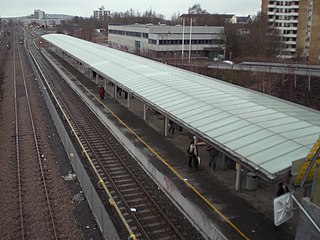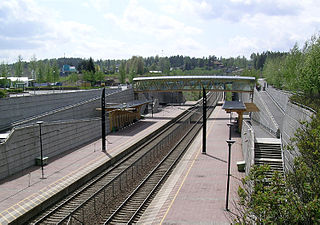
The Norwegian railway system comprises 4,109 km of 1,435 mm track of which 2,644 km is electrified and 274 km double track. There are 697 tunnels and 2,760 bridges.
The Airport Express Train is a Norwegian high-speed airport railway service connecting Oslo Airport to Oslo Central Station in nineteen minutes. Run by Flytoget AS, it operates on the high-speed Gardermoen Line using sixteen GMB Class 71 electric trains. Normal service frequency is once every ten minutes, with five of the services each hour continuing westwards beyond Oslo Central. The extended services serve nine stops within Greater Oslo and take up to 60 minutes.

Vygruppen, branded as Vy, is a government-owned railway company which operates most passenger train services and many bus services in Norway. The company is owned by the Norwegian Ministry of Transport. Its sub-brands include Vy Buss coach services, CargoNet freight trains and the Swedish train transport company Tågkompaniet. In 2009, NSB carried 52 million train passengers and 104 million bus passengers. On 24 April 2019, passenger train and bus services were rebranded as Vy.

The Bergen Line or the Bergen Railway, is a 371-kilometre (231 mi) long scenic standard gauge railway line between Bergen and Hønefoss, Norway. The name is often applied for the entire route from Bergen via Drammen to Oslo, where the passenger trains go, a distance of 496 kilometres (308 mi). It is the highest mainline railway line in Northern Europe, crossing the Hardangervidda plateau at 1,237 metres (4,058 ft) above sea level.

Oslo Central Station is the main railway station in Oslo, and the largest railway station within the entire Norwegian railway system. It connects with Jernbanetorget station. It's the terminus of Drammen Line, Gardermoen Line, Gjøvik Line, Hoved Line, Østfold Line and Follo Line. It serves express, regional and local rail services by four companies. The railway station is operated by Bane NOR while its real estate subsidiary, Bane NOR Eiendom owns the station, and was opened in 1980.

Storo is a rapid transit station on the Ring Line of the Oslo Metro, and a tram station on the Grünerløkka–Torshov Line of the Oslo Tramway. It is located at Storo in the Nordre Aker borough of Oslo, Norway. The tram station opened on 28 November 1902, and the rapid transit station on 20 August 2003. Metro lines 4 and 5 run to the station. The tram station serves lines 11, 12 and 18. The station is within walking distance of Grefsen Station on the Gjøvik Line. The station also functions as a bus hub, being located along Ring 3. Storo is a mixed commercial and residential area, and a shopping center is located just north of the subway station.

Nydalen is a rapid transit station on the Ring Line of the Oslo Metro. It is located at Nydalen in the Nordre Aker borough of Oslo, Norway. The station opened on 20 August 2003, as part of the first section of the Ring Line to Storo. The station is served by lines 4 and 5 of the metro, as well as several local bus services. Artistic effort was put into the construction of the station, and the escalators were built into the Tunnel of Light exhibition. Close by the station is the BI Norwegian Business School (BI) campus and several large working places.

The Gardermoen Line is a high-speed railway line between Oslo and Eidsvoll, Norway, running past Lillestrøm and Oslo Airport, Gardermoen. The line is 64 kilometres (40 mi) long and replaced the older Hoved Line as the main line north-east of Oslo. The older Hoved Line now handles commuter and freight traffic, while the Gardermoen Line handles high-speed passenger trains and freight trains laden with jet fuel for the airport. Both lines are owned by Bane NOR.

The Oslo Tunnel is a 3,632-metre (11,916 ft), double-track, railway tunnel which runs between Olav Kyrres plass and Oslo Central Station (Oslo S) in Oslo, Norway. The tunnel constitutes the easternmost section of the Drammen Line and runs below the central business district of Oslo. It features the four-track Nationaltheatret Station, Norway's second-busiest railway station, where the Oslo Tunnels lies directly beneath the Common Tunnel of the Oslo Metro. At Frogner, the Elisenberg Station was built, but has never been used. The tunnel is the busiest section of railway line in Norway and serves all west-bound trains from Oslo, including many services of the Oslo Commuter Rail and the Airport Express Train.

The Asker Line is a 9.5-kilometre (5.9 mi) railway line between Asker and Lysaker in Norway. The line runs along the same corridor as the Drammen Line, offering increased capacity, speed and regularity on the rail network west of Oslo. The first part opened in 2005, and in 2011 an extension opened from Sandvika to Lysaker. Original plans called for an extension to Skøyen, but from 2020, new planning is under way for an extension all the way to Oslo Central Station. Most of the railway is in tunnel and is dimensioned for 160 km/h (99 mph) running. The entire railway is electrified at 15 kV 16.7 Hz AC. The first section cost 3.7 billion kr, while the second is budgeted at NOK 2.7 billion.

Lysaker Station is a railway station on the Drammen Line and Asker Line situated at Lysaker in Bærum, Norway. Located 7.00 kilometers (4.35 mi) from Oslo Central Station, Lysaker is served by a mix of Vy express, regional and Oslo Commuter Rail trains, as well as Flytoget. The station is elevated and features two island platforms with four tracks. It's the terminus of the Asker Line.

Roa Station is a railway station in Roa, Norway on the Gjøvik Line. It is served by Oslo Commuter Rail line trains operated by Vy Gjøvikbanen. The station was opened in 1909 as part of the new Roa–Hønefoss Line that connects the Bergen Line to the Gjøvik Line.

The Trøndelag Commuter Rail is a commuter train service operating in Trøndelag county, Norway. It was operated by Vy with Class 92 diesel multiple units, until 7 June 2020 when SJ Norge took over the contract until 2030. The service provides a commuter service connecting Trondheim to its suburbs, between towns in Innherred and as an airport rail link for Trondheim Airport, Værnes. Although passenger services have operated along the lines since 1864, the commuter train was created with an increase of service with existing rolling stock in 1993. In 2019, the system was used by 1.4 million passengers.
The Norwegian National Rail Administration was a government agency responsible for owning, maintaining, operating and developing the Norwegian railway network, including the track, stations, classification yards, traffic management and timetables. Safety oversight was the duty of the Norwegian Railway Inspectorate, while numerous operating companies run trains on the lines; the largest being the state owned passenger company Vy and the freight company CargoNet.

The Alna Line is a 4.3-kilometer (2.7 mi) railway line between Alnabru and Grefsen in Oslo, Norway. The single track line allows direct access between the Trunk Line and the Gjøvik Line, without having to pass via Oslo Central Station. The line is electrified and is owned by the Norwegian National Rail Administration. It is exclusively used by freight trains, and allows trains on the Bergen Line to reach Alnabru Freight Terminal.

Jaren Station is a railway station located at Jaren in Oppland, Norway. The station is the terminus for the Oslo Commuter Rail, but is also served by regional trains that continue to Gjøvik. Both services are provided by Vy Gjøvikbanen.
Ofotbanen Drift AS, trading as Ofotbanen, was a Norwegian passenger and freight railway company. The company operated a fleet of six locomotives, three multiple units, 22 passenger and 48 freight cars. The sole service was the passenger train Unionsexpressen between Oslo and Stockholm; it had previously offered freight haulage on contract.

Ruter AS is the public transport authority for Oslo and Akershus counties in Norway. Formally a limited company – 60% of its shares are owned by the Oslo county municipality and 40% by that of Akershus – it is responsible for the administration, funding, and marketing of public transport in the two counties, including buses, the Oslo Metro, Oslo Trams, and ferry services. Ruter also holds agreements with Norwegian State Railways concerning the regulation of fares on local and regional train services operated within the two counties.

Oslo Commuter Rail is a commuter rail centered in Oslo, Norway, connecting the capital to six counties in Eastern Norway. The system is operated by Vy and its subsidiary Vy Gjøvikbanen, using Class 69 and Class 72 electric multiple units (EMU). The network spans eight routes and 128 stations, with Oslo Central Station (Oslo S) as the central hub. The trains run on 553 kilometers (344 mi) of electrified mainline railway owned by the Bane NOR. Deficits are financed by the Norwegian Ministry of Transport, although the network also has a ticketing cooperation with Ruter, the public transport authority in Oslo and Akershus. The network is the longest commuter rail network in the Nordic countries, and among top ten in Europe.

Harestua Station is a railway station on the Gjøvik Line at Harestua in Lunner, Norway. Situated at 45.5 kilometers (28.3 mi) from Oslo Central Station (Oslo S), it consists of a side platform along a section of single track. It is served by line L1 of the Oslo Commuter Rail and regional trains on line R30, both operated by Vy Gjøvikbanen, each operating every two hours.




















